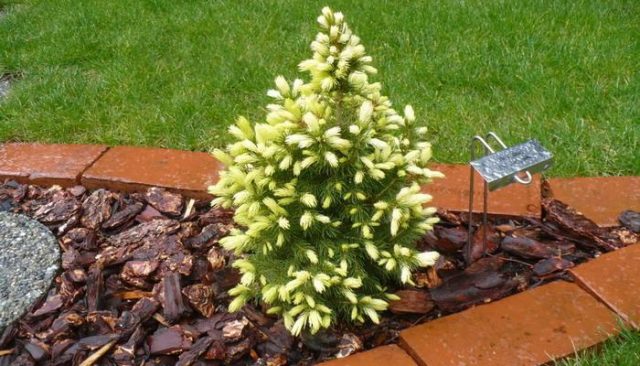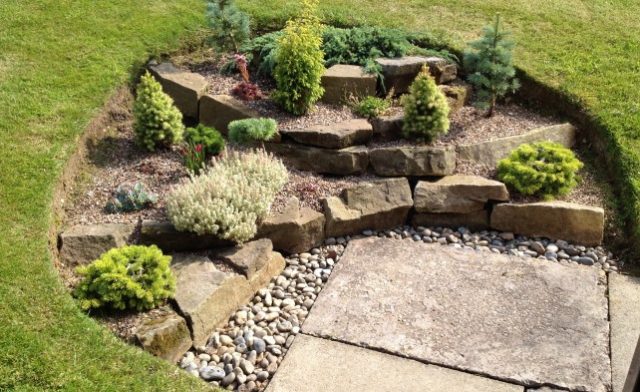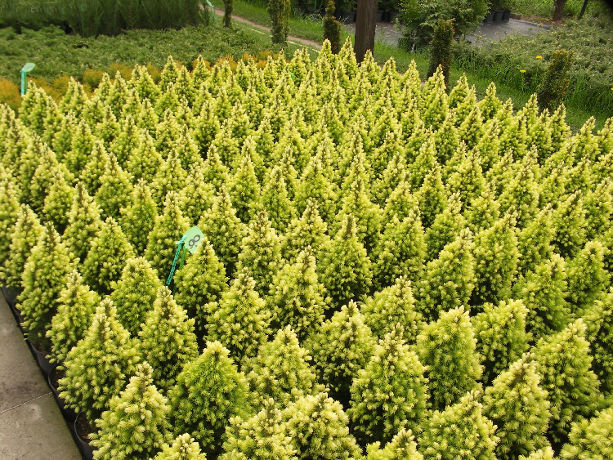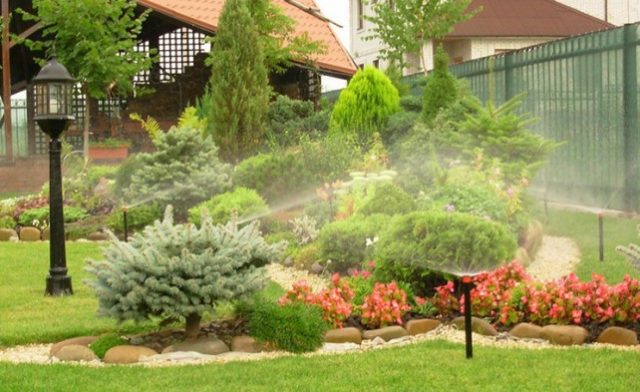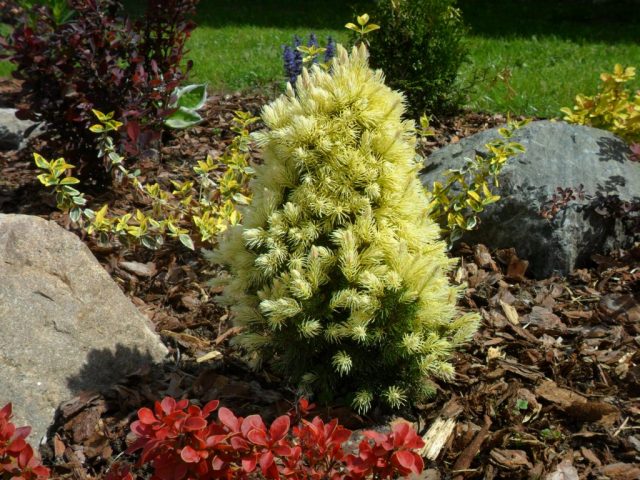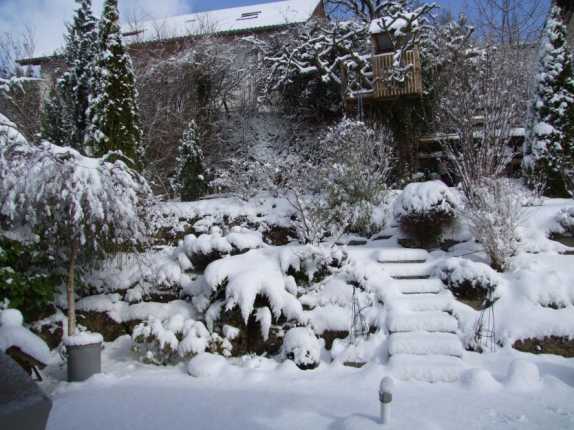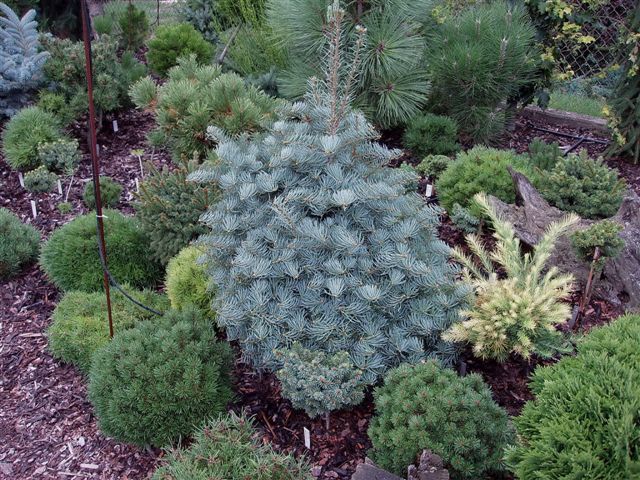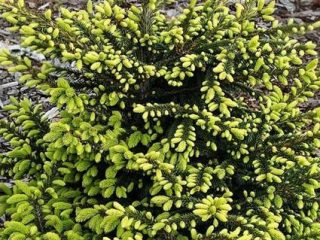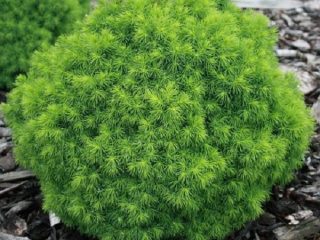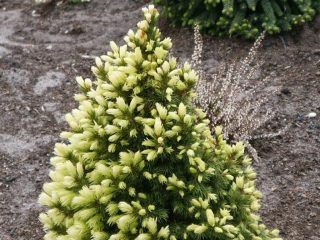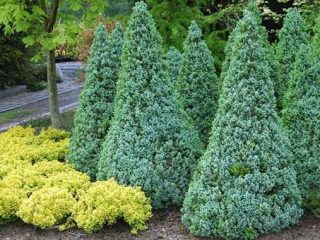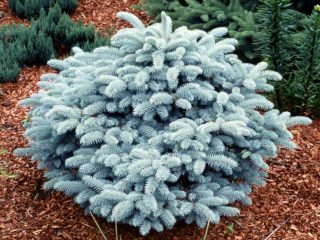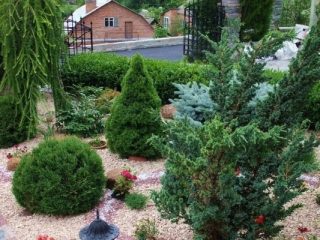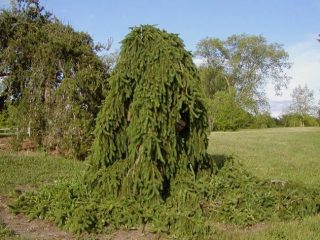Content
Canadian spruce Daisy White is a random mutation of the famous Konica, discovered in 1979. It was isolated in a Belgian nursery, where the characteristics of the new variety were polished and consolidated. Canadian spruce Daisy White could surpass its parent form in popularity, as it has exceptional decorative qualities. But she is even more of a sissy than Konika, so that the tree does not survive, but becomes a real decoration of the site, it will have to be constantly given attention. But the result is worth it.
Description of Canadian spruce Daisy White
One of the smallest varieties of Gray, Canadian or White Spruce (Picea glauca) is Daisy’s White. By the age of 10, it grows to 80-100 cm, at the age of 30 it reaches a maximum of about 2 m with a width of 0.8 m. It is interesting that in Russia and neighboring countries by this time Daisy White has a height of 1.5 m. All varieties of Canadian spruce are distinguished by this feature - in our country they grow lower than in Europe or America. This is probably due to the characteristics of the soil and climate.
The annual growth of the Canadian Daisy White spruce is 2-4 cm. At 6-7 years, a kind of jump occurs, and over the next few seasons the variety can add 10 cm in height. Then the growth rate slows down again to 1-2 cm.
It has been noted that the color of the needles of this variety depends on the growing conditions. Young shoots of Canadian spruce Daisy White can be white, cream, golden-green, yellowish-white. In the second half of summer they darken and turn green. Needles of any age do not exceed 9 mm in length, are soft to the touch, and when rubbed they emit a strong aroma. In the photo of Daisy White spruce, the contrast between old and young needles is clearly visible.
The crown of the tree is dense, since it has the same number of internodes as on the species plant, but as a result of mutation they have become very short. The Canadian Daisy White spruce grows like a small cone of regular shape, the branches completely cover the trunk. Deformation of the crown occurs only as a result of pruning frozen or sunburned shoots.
Cones on the Daisy White spruce appear extremely rarely. The root system comes close to the soil surface.
White spruce Daisy in landscape design
Conifers not only decorate the garden, but also cleanse the air of dust and pathogenic bacteria and saturate it with phytoncides. In addition, they do not lose their attractiveness in winter, and at least slightly enliven the monotonous white landscape.
The miniature size of the Canadian Daisy White spruce makes it indispensable for small areas. The tree is grown in rock gardens, rock gardens, flower beds and ridges. This spruce is planted in the foreground of landscape groups.
Although Daisy White is very attractive, it should not be used as a tapeworm even in small gardens - it simply does not look good in an open space alone. In addition, without cover, the needles burn heavily under the sun. But a brown spruce, or, even better, bald on one side, is somehow not suitable for a single focal plant.
But Daisy White looks good in gardens designed in Japanese or regular French style. A small variegated spruce would be appropriate in regular plantings, for example, as a repeating element when framing a parterre lawn or in long narrow edgings.
Just don’t plant the Daisy White Canadian spruce in the sun without protection from the south side - it will burn and ruin the view. But you can place it in the shade - the white needles will fade a little, but will still look attractive. Spruce looks good when placed together with plants that highlight its beauty. White and green needles allow you to plant flowers of any color nearby.
Canadian Daisy White spruce can be grown in containers. On the one hand, it is convenient; the pots can be rearranged from place to place, if necessary, decorating the front area, place of relaxation or receiving guests. On the other hand, Canadian spruce in containers requires more careful care than in open ground.
Some conifer lovers collect a collection of dwarf varieties. With skillful placement of plants, you can create a wonderful composition from them. The Canadian spruce Daisy White will also fit into it.
Planting and caring for the Canadian Daisy White spruce
Canadian spruce trees, including the Daisy White variety, have adapted well to Russian conditions, but they grow lower than in their homeland.Species plants do not tolerate air pollution well, while cultivars are more resistant to urban conditions.
The vitality of trees is quite high; the main problem when planting and caring for the Daisy White spruce is to maintain its decorative appearance. In the Middle Zone and the North-West, the needles suffer more from early spring needle burns; in the southern regions they burn in the summer.
Preparing seedlings and planting area
The description of the Canadian Daisy White spruce has little in common with the species plant, despite this, the changes affected only the appearance of the cultivar. The tree's needs remain the same as those of the original form, with the exception of its relationship to the sun - the white young growth burns under direct rays.
Daisy White can grow in rocky areas. In any case, the soil must be well-drained, permeable to air and water, acidic or slightly acidic. Moderately fertile sandy loams and loams, fresh and moist, are well suited.
Canadian spruce will tolerate temporary slight waterlogging, but not permanent moisture in the root area. Water should not approach the soil surface closer than 1.5 m. Soaking of the root collar is especially dangerous for Daisy White - the tree may die.
To prevent the needles from burning, Canadian spruce should be planted in partial shade. It is better if the crown is illuminated only early in the morning. But the areas are different, some have a lot of shade, others have sun, and besides, the landscape concept may require that the Daisy White spruce be located in an open place. Then the tree is placed so that on the south side it is covered from the sun by the shadow of other plants. There is no other way - the soft spruce needles will constantly burn. She is recovering, but it takes a long time.
Always covering a tree from the sun in the middle of the day is not an option. Firstly, for this, someone must always be at home, and secondly, the needles will burn, even if you forget to throw protection on the Canadian spruce once.
It is best to buy Canadian spruce seedlings at the age of 4-5 years, when the side branches appear. The tree must be grown in a container or sold with a ball of earth covered in burlap. You can purchase a spruce with bare roots only if it was dug up in the presence of the buyer, immediately dipped in a clay mash and wrapped in cling film.
Landing rules
The best time to plant Daisy White spruce is late fall. In the south they do this all winter. For the North-West and Siberia, early spring planting is acceptable, until the tree’s buds open.
A hole for planting is dug with a diameter of 60 cm and about 70 cm in depth. A drainage layer of expanded clay or broken red brick of at least 20 cm is poured onto the bottom. The planting mixture is prepared from turf soil, leaf humus, clay, sand and acidic peat. Up to 150 g of nitroammophoska is added as a starting fertilizer.
The pit is filled 2/3 full with the prepared mixture, completely filled with water and allowed to settle. Not earlier than after 2 weeks they begin planting:
- So much soil is taken out of the hole so that the root collar of the Canadian spruce is flush with its edge.Important! If Daisy White was sold with a burlap-lined earthen ball, there is no need to remove the fabric.
- Cover the root with the planting mixture, constantly compacting it to avoid the formation of voids.
- Check the position of the root collar and correct if necessary.
- From the remaining soil, make a roll along the contour of the planting hole and water the seedling abundantly.
- When the liquid is completely absorbed, the soil is mulched with the bark of coniferous trees during spring planting, and in the fall with a layer of at least 5 cm of acidic peat.
Watering and fertilizing
In the first 2 weeks after planting the Canadian Daisy White spruce, the soil is not allowed to dry out; the seedling is watered at least 2 times a week, more if necessary. Further moistening is carried out regularly, but not excessively. During hot summers, weekly watering may be required.
Canadian spruce Daisy White is demanding on air humidity. It needs to be hosed down regularly. If the site has automatic watering with retractable nozzles, it can be turned on daily for 5 minutes at 5-8 o’clock in the morning. The Daisy White spruce is small, the crown will have time to become saturated with moisture and dry out before the sun becomes too active (up to 10-11 hours).
You can postpone sprinkling the crown to the evening. Water treatments at 5-6 p.m. will not cause sunburn, and the branches will have time to dry before nightfall. If the spruce remains wet at night, this can provoke the development of fungal diseases.
Young Canadian spruce must be fed; after 10 years, it is advisable. It is better to use fertilizers specifically designed for coniferous crops. When purchasing them, you should pay attention to what season the fertilizing is intended for - this is indicated on the packaging.In spring, nitrogen should predominate in the fertilizer, in autumn - phosphorus and potassium.
Foliar feeding is no less important for the Canadian Daisy White spruce. Necessary microelements are better absorbed through pine needles, in chelated form. They can be given no more than once every 14 days. It is recommended to add an ampoule of epin or zircon to the bottle, and when the young needles turn green, an additional dose of magnesium.
Mulching and loosening
The root system of spruce trees comes close to the soil surface. It needs to be loosened to a depth of no more than a few centimeters. This procedure is most important for young plants after watering.
A few years after planting, loosening is replaced by mulching with acidic peat or fungicide-treated conifer bark.
Mulching not only protects the soil from drying out, but also prevents the lower branches from lying directly on the ground. This, in turn, protects the spruce from infection by pathogenic bacteria and fungi in the soil.
Trimming
The Canadian Daisy White spruce has a beautiful cone-shaped crown. There is no need to form it. It is almost impossible to do sanitary pruning of dried shoots - the variety was obtained as a result of a mutation, and the tiny tree has the same number of branches as the species plant. It's just that the internodes are located close to each other. You can cut them only by spreading the needles, and this will take all day.
Although very rare, sometimes a small Canadian spruce grows a branch of normal size. It must be cut out immediately to preserve the variety.
Crown cleaning
The compressed dense crown of the Canadian Daisy White spruce contributes to the rapid drying out of the needles inside and shoots deprived of light. Not only the sun's rays cannot penetrate there, but also vital moisture cannot penetrate there. If you shake an unkempt spruce, a cloud of dust will fly out of it. Such a plant will not only get sick often, but will also quickly lose its decorative value. It will saturate the air not with phytoncides, but with tiny pieces of pine needles and bark mixed with mites that irritate the mucous membrane.
To avoid this, you should clean the crown of the Canadian Daisy White spruce every year, and when treating and foliar feeding, be sure to move the needles apart, wetting the entire tree with the preparations. Without this, the trunk and internal branches will become a breeding ground for diseases and pests.
When cleaning the crown, you should take protective measures - wear a respirator, safety glasses, sleeves and gloves.
Cleaning is carried out at least 3 times per season:
- the first two times in early spring with an interval of 14 days;
- the third - in the fall, during preparation for winter.
The procedure itself is carried out on a dry, windless day:
- Gently push apart the needles of the Canadian Daisy White spruce with your hands and clean off all the dry needles.
- Remove fallen needles from lower branches and soil.
- Treat the outer and inner parts of the crown, as well as the soil under the tree, with a fungicide, preferably copper-containing.
- Wash your hands and face thoroughly with soap.
Preparing for winter
Daisy White, like all Canadian spruce trees, tolerates Russian conditions well. Without shelter, it overwinters in zone 4. Only young trees require protection in the year of planting - the soil under them is mulched with acidic peat, the crown is wrapped in white agrofibre or spandbond, and secured with twine. You can use spruce branches instead of non-woven material.
In subsequent years, they limited themselves to mulching the tree trunk circle of the Daisy White spruce with peat. If frost is expected in the North-West, Urals and Siberia after the young needles bloom, the tree should be covered with burlap or other material. The trunk, roots and mature needles are not in danger, but the white young shoots may freeze.
The winter hardiness of gray or white Daisy White spruce is increased by moisture replenishment and autumn phosphorus-potassium fertilizing.
Sunburn protection
Starting from mid-February, Canadian spruce should be covered with white non-woven material to protect it from sunburn. At this time, the needles quickly lose moisture, and the root located in the frozen ground cannot replenish it.
When the water balance is restored, the Daisy White spruce, planted without cover, still suffers from direct rays - the sensitive white tips can burn. They fall off, and the tree loses its decorative effect for at least a season. They increase stability by sprinkling the crown, regular fertilizing and spraying with epin twice a month.
When the needles turn from white to green, only the southern side of the Canadian spruce will suffer. To avoid unnecessary hassle, you can plant a plant next to Daisy White that will at least slightly shield her from direct sunlight.
Reproduction
The seeds of the Canadian Daisy White spruce will grow into a species plant. It is propagated by grafting or cuttings.Vaccinations should be done by a specialist, and you can try to root the shoots yourself, even though there will be a lot of attacks.
Cuttings are planted throughout the season, until the first frost, but spring cuttings take root faster. A shoot 10-12 cm long is cut off from the older branch along with the heel (a piece of bark), the lower part is freed from needles, and treated with a growth stimulator. Planted in a cold greenhouse to a depth of 2-3 cm.
You can root cuttings of Canadian Daisy White spruce in perlite, clean sand or a mixture of sand and peat in containers with drainage holes. The substrate should always be moist, but not wet.
Only a few of the shoots will survive. When they begin to grow, the cuttings planted in a cold greenhouse begin to be fed, and from the containers they are transplanted into separate cups with a mixture of sand and leaf humus. They are moved to a permanent place at the age of 4-5 years, when side shoots appear.
Diseases and pests
In order for the Canadian Daisy White spruce to get sick less often and be less affected by pests, you should regularly clean the crown, carry out sprinkling and preventive treatments. Experienced gardeners examine the tree with a magnifying glass once a week in order to notice the first signs of trouble as early as possible and immediately begin treatment.
Canadian spruce is most often affected by diseases:
- regular and snow shutte;
- rust;
- spruce spinner;
- fusarium;
- rot;
- wound cancer;
- necrosis of the cortex.
Common pests;
- mites;
- nun butterfly;
- gall aphids;
- spruce budworm;
- mealybug;
- spruce sawyer;
- Hermes.
When conifers are damaged by insects, you must immediately use insecticides, and fight diseases with the help of fungicides. Particular attention should be paid to the inside of the crown.
Reviews of Canadian spruce Daisy White
Conclusion
Canadian spruce Daisy White requires special attention. It needs to be protected from heat and sun, the crown cleaned and sprinkled. But the tree is so beautiful and small that it will not be difficult for a true connoisseur of coniferous plants to keep its crown in order.

